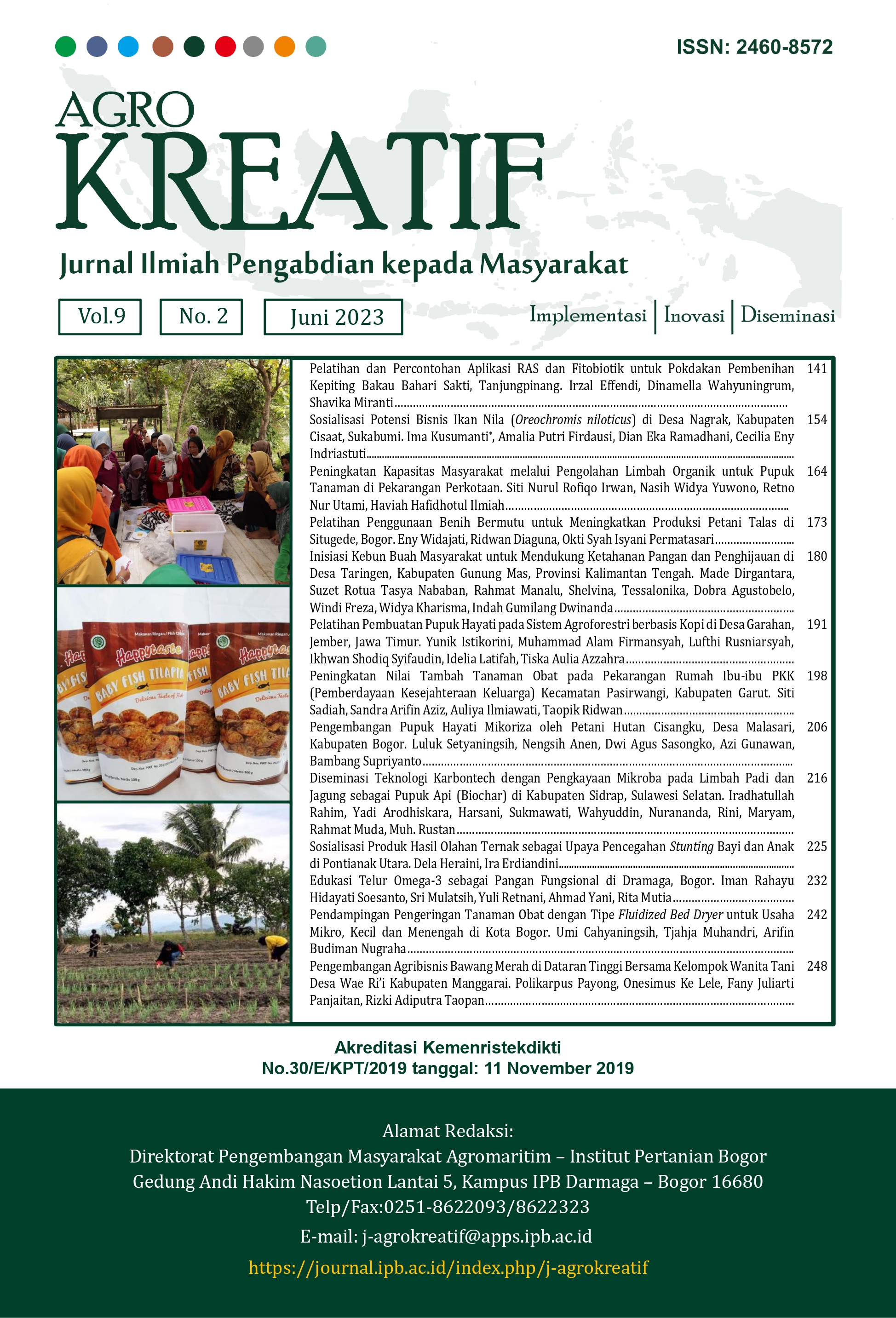Diseminasi Teknologi Karbontech dengan Pengkayaan Mikroba pada Limbah Padi dan Jagung sebagai Pupuk Api (Biochar) di Kabupaten Sidrap, Sulawesi Selatan
Abstract
This activity aims to disseminate carbon tech technology and enrichment using microbes in agricultural waste into nutrient-rich biological charcoal. The products produced and the technology used was disseminated to farmers to utilize sandy land, which is marginal land in Ciro-Ciroe Village, Sidrap Regency, South Sulawesi. This activity also involved 5 students as participants in the Independent Study program in the MBKM program and members of the Mallawa Farmers Group. The implementation method is by conducting socialization and counseling about using organic matter to restore soil fertility. Demonstrations of activities were carried out starting from making biochar to application on sandy land with an area of 700 m2 as a demonstration plot for shallot cultivation. The results showed that the organic matter produced using carbon-tech technology had a neutral pH, namely 6.66‒7.22, the highest C content was in rice husk biochar applied by Pleurotus sp, namely 21.45, and the best maturity level was in corncob biochar + Pleurotus sp, namely 17. The highest N was in corn cob + Pleurotus biochar, the highest P content was in rice husk + Pleurotus biochar, while the highest K content was in corn cob + compost + Pleurotus biochar. These results indicate that applying microbial-enriched fire fertilizers and compost is very suitable for sandy land managed by farmers in Ciro-Ciroe, Sidrap Regency. This application is highly recommended for sandy land to produce superior commodities sustainably and environmentally friendly manner.
Downloads
References
Andrenelli MC, Maienza A, Genesio L, Miglietta F, Pellegrini S, Vaccari FP, Vignozzi N. 2016. Field application of pelletized biochar : Short term effect on the hydrological properties of a silty clay loam soil. Agricultural Water Management. 163: 190–196. https://doi.org/10.1016/j.agwat.2015.09.017
Asai H, Samson BK, Stephan HM, Songyikhangsuthor K, Homma K, Kiyono Y, Horie T. 2009. Biochar amendment techniques for upland rice production in Northern Laos. Field Crops Research. 111(1–2): 81–84. https://doi.org/10.1016/j.fcr.2008.10.008
Asrul L, Rahim I, Kuswinanti T, Rasyid B, Nasruddin A. 2018. Effect of cocoa pod husk compost produced using rot fungi on the growth of cocoa seedlings. OnLine Journal of Biological Sciences. 18(1): 69‒73. https://doi.org/10.3844/ojbsci.2018.69.73
[BPS] Badan Pusat Statistik. 2020. Provinsi Sulawesi Selatan dalam angka. Makassar (ID): Badan Pusat Statistika.
Gadde B, Bonnet S, Menke C, Garivait S. 2009. Air pollutant emissions from rice straw open field burning in India, Thailand and the Philippines. Environmental Pollution. 157(5) 1554–1558. https://doi.org/10.1016/j.envpol.2009.01.004
Githinji L. 2014. Effect of biochar application rate on soil physical and hydraulic properties of a sandy loam. Archives of Agronomy and Soil Science. 60(4): 457‒470. https://doi.org/10.1080/03650340.2013.821698
Iradhatullah R, Kuswinanti T, Asrul L, Rasyid B. 2015. Growth Rate and Indole Acetic Acid Production of Several Fungal Rot Isolates. International Journal of Science and Research. 4(6): 1636–1638.
Laird D, Fleming P, Wang B, Horton R, Karlen D. 2010. Biochar impact on nutrient leaching from a Midwestern agricultural soil. Geoderma. 158(3–4): 436–442. https://doi.org/10.1016/j.geoderma.2010.05.012
Lehmann J, Joseph S. 2009. Biochar for Environmental Management : An Introduction. London (UK): Taylor and Francis Group. Page: 1–12.
Liu S, Meng J, Jiang L, Yang X, Lan Y, Cheng X, Chen W. 2017. Rice husk biochar impacts soil phosphorous availability, phosphatase activities and bacterial community characteristics in three different soil types. Applied Soil Ecology. 116: 12–22. https://doi.org/10.1016/j.apsoil.2017.03.020
Ngindi RA, Udayana BI, Situmeang YP. 2022. The Effect of Compost and Biochar Fertilizers on The Growth and Yield of ShallotsYield of Shallots. Agriwar Journal. 2(2). 49–54. https://doi.org/10.22225/aj.2.2.2022.49-54
Olson A, Clemmensen KE. 2016. Mycorrhizal and saprotrophic fungal guilds compete for the same organic substrates but affect decomposition differently. Functional Ecology. 30(12): 1‒12. https://doi.org/10.1111/1365-2435.12677
Pramesti R. 2018. Exploration of Wooden Milk and Its potential in Botani Sukorambi Park of Jember District. Jember (ID): Universitas Muhammadiyah Jember.
Putra IVANP, Mardiyah ERA, Amalia NS, Mountara A. 2017. Ragam Jamur Asal Serasah dan Tanah di Taman Nasional Ujung Kulon Indonesia. Jurnal Sumberdaya Hayati. 3(1): 7–10. https://doi.org/10.29244/jsdh.3.1.1-7
Rahim I, Suherman, Nasruddin A. 2020. Colony interaction of rot fungi consortium to enrich cocoa pod husk compost. Plant Cell Biotechnology and Molecular Biology. 21(21–22): 113‒122.
Satria M, Noviar H, Hamzah F, Pramana A. 2021. Characteristics of Charcoal Briquettes Corn Cobs Charcoal with the Addition of Areca Peel Charcoal. In Journal of Physics: Conference Series. IOP Publishing. https://doi.org/10.1088/1742-6596/2049/1/012082
This work is licensed under a Creative Commons Attribution-NonCommercial 4.0 International License.



















